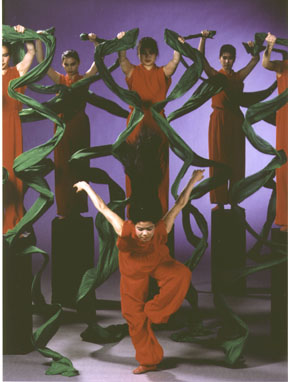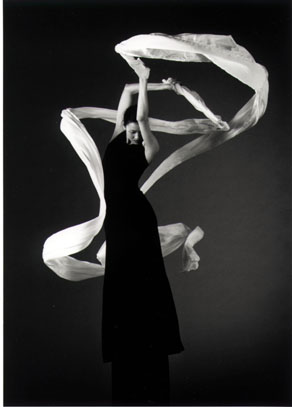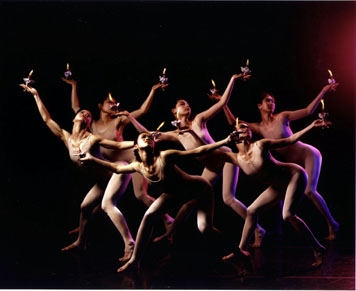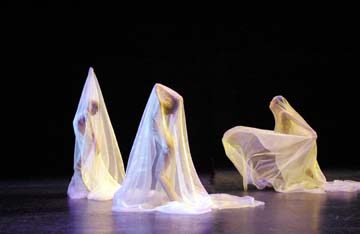Silken Illusions
15th
Anniversary Performance
Lili Cai Chinese Dance Company
Yerba Buena Center for the Arts Theater
San Francisco, California
November 15, 2003
by
Paul Parish
copyright © 2003 by Paul Parish
 The
most interesting part of the Lili Cai Chinese Dance Company's fifteenth
anniversary show last Saturday night was the series of stunning clips
in the video retrospective, which was screened just before the intermission.
The marvelous deep, high stage of the theater at the Yerba Buena Center
for the Arts downtown had just been filled with the snaking whorls of
traditional Chinese ribbon dancing, beautifully lit, which at moments
caught me up in complete fascination, watching the gorgeous silk reveal
the inner secrets of turbulent currents, but then left me wool-gathering,
reflecting (for example) on the possible debt of Loie Fuller to this form
of Chinese dancing. The three dances performed that evening were too similar.
In all of them, the dancers were there to make other things dance—you
followed the movements of cloth, or of flames, not the bodies of the dancers.
Which that night, for me, let me drift off into thought. But the clips
in the video arrested me, held me tight, impressed me repeatedly with
how strong the company is, how varied their repertory, how open they are
to new influences and how successful they are in collaborating with artists
from other cultures. I found myself wishing they were performing at least
one dance that was more rhythmic and embodied, like their award-winning
Common Ground (which they co-created with the African-heritage
Dimensions Dance Theater) and is strong, earthy, and grounded.
The
most interesting part of the Lili Cai Chinese Dance Company's fifteenth
anniversary show last Saturday night was the series of stunning clips
in the video retrospective, which was screened just before the intermission.
The marvelous deep, high stage of the theater at the Yerba Buena Center
for the Arts downtown had just been filled with the snaking whorls of
traditional Chinese ribbon dancing, beautifully lit, which at moments
caught me up in complete fascination, watching the gorgeous silk reveal
the inner secrets of turbulent currents, but then left me wool-gathering,
reflecting (for example) on the possible debt of Loie Fuller to this form
of Chinese dancing. The three dances performed that evening were too similar.
In all of them, the dancers were there to make other things dance—you
followed the movements of cloth, or of flames, not the bodies of the dancers.
Which that night, for me, let me drift off into thought. But the clips
in the video arrested me, held me tight, impressed me repeatedly with
how strong the company is, how varied their repertory, how open they are
to new influences and how successful they are in collaborating with artists
from other cultures. I found myself wishing they were performing at least
one dance that was more rhythmic and embodied, like their award-winning
Common Ground (which they co-created with the African-heritage
Dimensions Dance Theater) and is strong, earthy, and grounded.
The video made clear just how much Lili Cai's work is a spectacle. When they opened for the Grateful Dead a few years back, the crowd at the Colisseum went wild when they did their hundred-armed Buddha effect, it was the image that did it. The effect is a traditional Chinese dance-theater optical illusion, created by lining all the dancers up perpendicular to the audience and having them open their arms in an elaborate sequence—which may look even better on video than in 3-D, because it is designed to create a mythic pattern in two dimensions, like a painting. Similarly, many of the ribbon dances look in some ways MORE stunning in two dimensions than in three, like calligraphy of the utmost fantasy--and certainly the video collaboration they did with Ed Tennenbaum, who let the trajectories of the ribbons lay down tracks one upon another on his screen, looks like a new form of action painting—on-going marbling. It was a light show that did not stop being fascinating.
 Cai,
who came to San Francisco from Shanghai, where she was a principal dancer
with the Shanghai Opera House, came to the Bay Are twenty years ago and
quickly set about teaching and making contemporary dances using traditional
Chinese materials. The civilization of China is an ancient one, of course.
It embraces many cultures, has gone through many stages, and has survived
and assimilated the cultures of conquerors and the conquered. It's humbling
for an outsider like me to begin to imagine how ignorant I am of what
goes into this art. One thing that seems to pervade Chinese art, though,
is a fascination with the beauty of that which vanishes. The beauty of
the ribbon dances is both philosophical and sensuous—you see the
consequences of very small movements (made by the dancers' hands) as they
are played out in the yards and yards of silk that have been set in motion
and are being pulled through serpentine paths—it's like being able
to see the wind, or the passage of time itself, watching the silk whorl
and ripple and curl back on itself, all going by so fast you can't be
sure what you saw. In the interstices of the movement, I found myself
reflecting on the Chinese fascination with fireworks—which is also
a vanishing act that takes place in the air, in the dark—and with
gambling, the manifold unknowable unforeseeable permutations that can
come from a single initiative.
Cai,
who came to San Francisco from Shanghai, where she was a principal dancer
with the Shanghai Opera House, came to the Bay Are twenty years ago and
quickly set about teaching and making contemporary dances using traditional
Chinese materials. The civilization of China is an ancient one, of course.
It embraces many cultures, has gone through many stages, and has survived
and assimilated the cultures of conquerors and the conquered. It's humbling
for an outsider like me to begin to imagine how ignorant I am of what
goes into this art. One thing that seems to pervade Chinese art, though,
is a fascination with the beauty of that which vanishes. The beauty of
the ribbon dances is both philosophical and sensuous—you see the
consequences of very small movements (made by the dancers' hands) as they
are played out in the yards and yards of silk that have been set in motion
and are being pulled through serpentine paths—it's like being able
to see the wind, or the passage of time itself, watching the silk whorl
and ripple and curl back on itself, all going by so fast you can't be
sure what you saw. In the interstices of the movement, I found myself
reflecting on the Chinese fascination with fireworks—which is also
a vanishing act that takes place in the air, in the dark—and with
gambling, the manifold unknowable unforeseeable permutations that can
come from a single initiative.
 Candelas,
an adagio for five women in flesh-colored unitards carrying a candle in
each hand, opened the second half. What a relief it is to see a culture
where feminism has not made women self-conscious about seduction. Candelas
looks to me—admittedly, very much an outsider—like an outgrowth
of the dance of concubines: it is a high-minded, even sublime setting
of the Adagietto from Mahler's Fifth Symphony, the best dance setting
I have ever seen to that music (and there have been many). What makes
it work for me is the basis of the movement in an erotic mode of contortion.
The dancers reach behind themselves (holding candles, remember)-- investigating
the possibilities of rotation in the spine, the shoulder and elbow, that
will allow them to move these flames in figures of eight with maximum
amplitude and grace. The difficulty is the measure of its generosity.
The silhouette in this dance looks astonishingly African; the pelvis is
marvellously atilt, the lumbar arch is pronounced, the arms serpentine,
the knees almost always bent, sometimes all the way to the floor. The
ballerina repeatedly does a fondu all the way down on the right foot,
with the left extended in tendu, as she reaches forward in the breast,
all the while bearing a living flame in slow wreathing circles. At the
last great climax in the music, the candles suddenly configure in a huge
oval that reminds me of Tantric images of the Buddha, and reminds me that
the Tantric path ("the road of excess leads to the palace of wisdom"
is a line from Blake, but it encapsulates Tantric thought) is the high
erotic mode, with much in common with Rumi, The Song of Songs, and indeed,
the Fifth Symphony of Mahler.
Candelas,
an adagio for five women in flesh-colored unitards carrying a candle in
each hand, opened the second half. What a relief it is to see a culture
where feminism has not made women self-conscious about seduction. Candelas
looks to me—admittedly, very much an outsider—like an outgrowth
of the dance of concubines: it is a high-minded, even sublime setting
of the Adagietto from Mahler's Fifth Symphony, the best dance setting
I have ever seen to that music (and there have been many). What makes
it work for me is the basis of the movement in an erotic mode of contortion.
The dancers reach behind themselves (holding candles, remember)-- investigating
the possibilities of rotation in the spine, the shoulder and elbow, that
will allow them to move these flames in figures of eight with maximum
amplitude and grace. The difficulty is the measure of its generosity.
The silhouette in this dance looks astonishingly African; the pelvis is
marvellously atilt, the lumbar arch is pronounced, the arms serpentine,
the knees almost always bent, sometimes all the way to the floor. The
ballerina repeatedly does a fondu all the way down on the right foot,
with the left extended in tendu, as she reaches forward in the breast,
all the while bearing a living flame in slow wreathing circles. At the
last great climax in the music, the candles suddenly configure in a huge
oval that reminds me of Tantric images of the Buddha, and reminds me that
the Tantric path ("the road of excess leads to the palace of wisdom"
is a line from Blake, but it encapsulates Tantric thought) is the high
erotic mode, with much in common with Rumi, The Song of Songs, and indeed,
the Fifth Symphony of Mahler.
 The
evening's premiere, Si Ji ("the Four Seasons"), is
a veil dance: each of the dancers is covered with a good ten yards of
sheer silk organza, which they poke and poke and poke and poke and jump
about inside, causing the stuff to do what you'd expect. BEAUTIFUL stuff,
beautifully lit (by Clyde Sheets) in colors designed to suggest the changing
seasons. The dance could not hold my attention, despite its arresting
score, composed for the occasion by company's co-founder, Gang Situ, and
brilliantly played by the solo cellist, Robin Bonnell. Again, I found
my mind wandering: the last section, which the dancers performed with
the organza tied around their bodies under the breast, brought back such
stunning memories of Balanchine's Bugaku (where the ballerina
performs pirouettes and other movements of grand adagio while swathed
in an awful lot of very similar cloth), made me wonder if this is an ancient
genre in China which the Japanese adopted into Gagaku and Balanchine incorporated
into his piece.
The
evening's premiere, Si Ji ("the Four Seasons"), is
a veil dance: each of the dancers is covered with a good ten yards of
sheer silk organza, which they poke and poke and poke and poke and jump
about inside, causing the stuff to do what you'd expect. BEAUTIFUL stuff,
beautifully lit (by Clyde Sheets) in colors designed to suggest the changing
seasons. The dance could not hold my attention, despite its arresting
score, composed for the occasion by company's co-founder, Gang Situ, and
brilliantly played by the solo cellist, Robin Bonnell. Again, I found
my mind wandering: the last section, which the dancers performed with
the organza tied around their bodies under the breast, brought back such
stunning memories of Balanchine's Bugaku (where the ballerina
performs pirouettes and other movements of grand adagio while swathed
in an awful lot of very similar cloth), made me wonder if this is an ancient
genre in China which the Japanese adopted into Gagaku and Balanchine incorporated
into his piece.
So they look like jellyfish, or like chicks about to hatch, or silk-worms struggling to be born. Or like Wilis preparing to dance. Except that none of these made much impact on me, and the idea of the four seasons would never have occurred to me if I had not read about it. What I missed most was a sense of rhythm, trajectory, and ballon in the allegro, which to me seemed choppy and frantic rather than airborne and natural (which I presume is the intention, but I admit that is a LARGE presumption). I'm not blaming the dancers for not providing these qualities. Perhaps, on another night, I would have been able to do without them. The dancers are lovely and certainly jump well—they are all beautifully trained, finely disciplined theater artists. Their names are Yan Hai, Quiong Huang, Tammy Li, Ada Liu, Chih-Ting Shih, and Phong Voong.
Photos:
First:
Begin from here.
Second: Strings Calligraphy
Third:
Candelas.
Fourth: Si Ji
Photo credit: Marty Sohl
To learn more about the Lily Cai Chinese Dance Company. Visit www.ccpsf.org
Originally published:
www.danceviewtimes.com
Volume 1, Number 9
November 24, 2003
Copyright ©2003 by Paul Parish
|
|
|